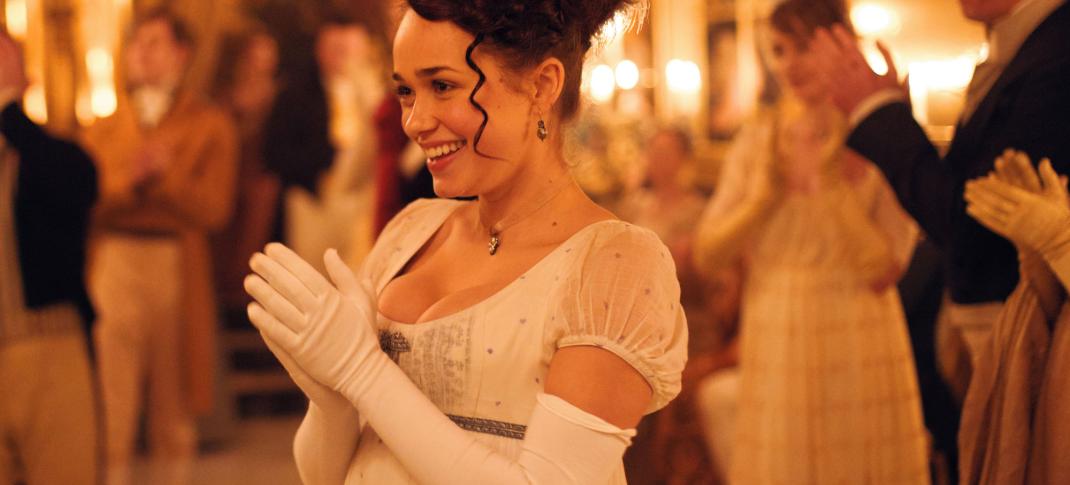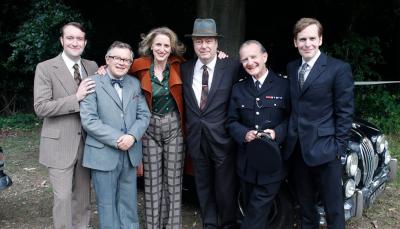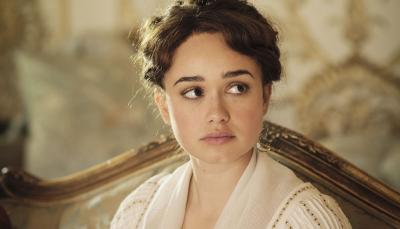'Sanditon' Recap: Episodes 1 and 2

MASTERPIECE Sanditon Episode One Sunday, January 12, 2020; 9:00 - 10:00pm ET A coach accident introduces Charlotte Heywood to Tom Parker and later his brother Sidney, commencing adventures in the struggling seaside resort of Sanditon. Shown: Charlotte Heywood (ROSE WILLIAMS) For editorial use only.
Copyright © RED PLANET PICTURES
One of the most intriguing aspects of Sanditon, the new Masterpiece drama adapted from the existing scraps of a would-be Jane Austen novel, is that we have no idea where it’s going. Like, at all. Austen only wrote 11 chapters of this story before she died, which was barely enough time to introduce the major characters, let alone give us any sense of what she had in store for them. On some level, this show is simply very expensive fanfiction. On another, it’s an exciting communal journey we’ve all never shared before – experiencing an Austen story together for the first time.
Well, sort of anyway. For that sort of lofty vision to work, you have to accept that the bulk of this story doesn’t come from Austen, but from writer Andrew Davies, the guy that’s given us multiple iconic adaptations of her work over the past three decades. (Seriously, sir, thank you for Colin Firth.) You kind of have to be okay from jump with the fact that he’s making something like 95% of this story up. Sure, he uses tons of twists and tropes that Austen loved (oh wow, how weird that Sidney Parker is a rude jerk with a huge heart hidden underneath!), but we can’t guarantee that they’re the same ones she would have chosen had she gotten the chance to finish her novel.
But there are certainly enough pieces here to wonder – and to make some observations about how this story does differ from her other work. Though Sanditon is in many ways a standard tale of class and manners, it’s not about a woman trying to find a husband for herself or her friends. Nor is it a story that’s exclusively taking place among the landed – or the genteelly poor – gentry. Instead, it’s a broader tale; one that incorporates aspects of community and capitalism and the roiling social changes of the time. The Parkers are entrepreneurs overtly trying to make money! Charlotte hunts with a gun! Women are going sea bathing! It’s all very exciting and industrial!
In short, it’s not your typical Austen tale, nor is this a typical Austen adaptation. There are so many things that seem strange or out of place at times (more on that in a moment), particularly if what you’re looking for is the familiar comfort of the classic tropes and stories Austen is famous for. But there are also intriguing risks, many of which feel fresh and almost revelatory at times.

One of those things is our heroine. Charlotte Heywood, for the record, is hands down the best part of Sanditon. Rose Williams is wonderful as a more down-to-earth version of every Austen heroine who has come before her, with a refreshingly clear-eyed vision of herself and a charming sense of curiosity. We first meet Charlotte shooting a gun and chasing after a runaway carriage, and her character pretty much just develops from there.
She’s an intriguing mix of wide-eyed wonder and steely determination, who is unafraid to stand up to others, defend those that need help or apologize when she feels she’s done wrong. She’s also intriguingly middle class, the daughter of a farmer with eleven other siblings and no real prospects for herself or a life outside her rural town. And her enthusiasm for all things Sanditon – whether it’s balls or sea bathing or awkward Lady Denham-sponsored luncheons – is so expansive, it makes me want to like all those things too. Or at least give them a chance.
By the end of the premiere set of episodes I desperately want Charlotte to find happiness on her own terms, even if I think that may involve getting away from the majority of these people as soon as possible.
Unfortunately, most of the supporting characters in Sanditon feel largely forgettable, with a couple of notable exceptions I’ll get to in a moment. As much as I generally like Kris Marshall, Tom Parker is an idiot whose grand financial schemes seem to involve little more than sucking up to the town’s rich widow. I don’t know if he’s the person to lead Sanditon into the entrepreneurial age, is what I’m saying.

Creepy step-siblings Edward and Esther and their bizarre sexual tension seem to have wandered in from a V.C. Andrews novel, and as much as I want to root for Lady Dehnam’s poor relation Clara, her bland, sticklike personality isn’t helping things much. Here’s hoping the fact that these three are clearly involved in Sanditon’s wildest, soapiest plot will eventually at least make their interactions fun to watch.
And then there’s Sidney Parker. The character has a few things going for him, beyond the obvious easy-on-the-eyes factor. I’ve loved Theo James for forever, and I’m always a sucker for a Darcy-type with a messy past. He’s so obviously meant to be with Charlotte that the bit where he tells her precisely how little he thinks of her feels kind of like a waste of time, yet I still find myself into it anyway. I’m weak, I tell you. WEAK.
The other truly intriguing aspect of Sanditon is its introduction of Georgiana Lambe, a wealthy bi-racial heiress from the West Indies, who is (somehow?) Sidney’s ward. Georgiana is, by the way, a genuine Austen creation and the author’s first black character, which seems to indicate that the she may have something to say about the lives of people of color in Regency England. Alas, we can’t know for sure.

Still, Sanditon’s first two episodes take Georgiana seriously, showing us her struggle to live in a world which clearly considers her both someone to be envied for her wealth and an oddity to be gawked at, as well the very real racism she experiences at the hands of some of Sanditon’s elite. Though these scenes – especially the luncheon party at Lady Denham’s - are deeply uncomfortable to watch, there is something satisfying and necessary about the fact that the show doesn’t flinch from confronting them. Georgiana’s race and experience, at least thus far, are treated as legitimate plot points rather than window dressing.
The same, unfortunately, cannot be said for the addition of such overt sexual references. The decision to sex up Jane Austen probably made sense to someone on paper, and admittedly, it does add a certain modern frisson to the story. After all, Sanditon is set in tumultuous times, when the world was changing and Britain along with it. But for me, raised on the 90s Pride and Prejudice and Sense and Sensibility, in which holding hands was basically as good as wedding vows, it simply feels wildly un-Austenish. And, what’s worse, it’s not clear what any of it adds to the story in these first two episodes.
I mean, we already knew that Charlotte was a bit naïve and that Edward was a garbage human, so I’m not sure what the addition of his blatant forest hookup with Clara, his Flowers in the Attic vibes with his stepsister or the hordes of naked men running around comparing equipment really brought to the table, other than a bit of salacious shock value. Are we really looking to Jane Austen for that kind of thing? I’m not, and at various times it honestly distracted me from the larger story the show was trying to tell.
What did you think of the first two episodes of Sanditon? Let’s discuss.




